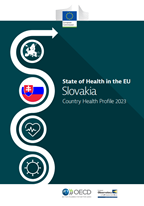HSPM
Health Systems and Policy Monitor

A compulsory social health insurance scheme in Slovakia covers nearly the entire population. The Health Care Surveillance Authority serves as an independent monitoring body for the health provision, insurance and purchasing markets. The Ministry of Health functions as the main regulatory body within the health system. It is also the single shareholder of the biggest health insurance company (VšZP), covering just over half of the population.
Three health insurance companies (one public and two private) operate the
compulsory health insurance system in Slovakia, setting up contracts with
health providers and negotiating quality, prices and volumes individually.
These companies compete to sign people up mostly based on shorter waiting times
and additional services.
The sources of revenue are mainly wage-related contributions paid by
employers and employees, along with general tax revenues used to pay
contributions for some subsidised categories of the population, such as
dependent family members, students and pensioners. Out-of-pocket (OOP) payments
in Slovakia correspond mainly to formal co-payments for prescribed outpatient
pharmaceuticals and user fees for health services or goods not covered by
health insurance companies.
Overall, the health system remains very hospital-centric, with a limited
role for primary care. GPs act as formal gatekeepers of the
health system but this role is not well enforced, and patients often
see specialists directly without, in practice, bearing any form of penalty.
Even though the eight self-governing regions are required to ensure minimum
GP-to-population ratios, accessibility of primary care varies and is reported
to be problematic in several regions.
Subscribe to our newsletter
Sign Up